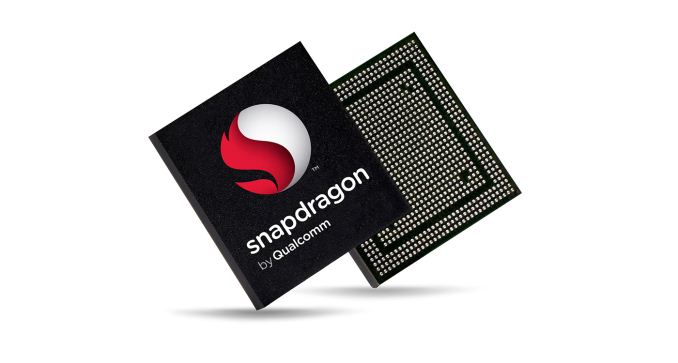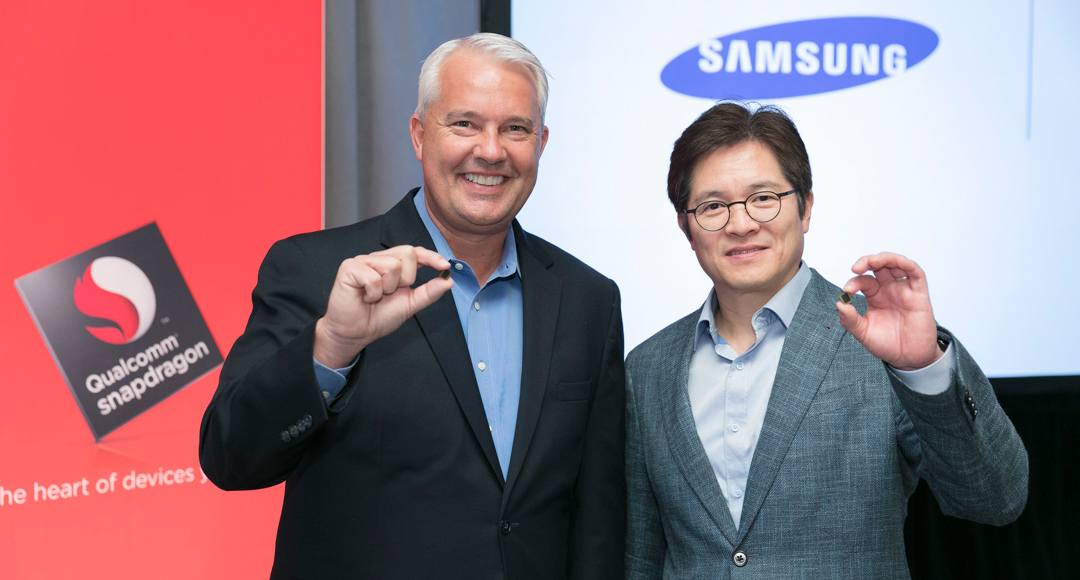Qualcomm Announces Next-Generation Snapdragon 835 SoC Using Samsung’s 10nm Node
by Matt Humrick on November 17, 2016 7:30 AM EST- Posted in
- Smartphones
- Samsung
- Snapdragon
- Qualcomm
- Mobile
- Snapdragon 835

Qualcomm revealed the name of its newest SoC, the Snapdragon 835, at its Snapdragon Technology Summit in New York today. The new SoC replaces the Snapdragon 820/821 at the top of its lineup. While Qualcomm is not yet ready to disclose the specifics about what’s inside the Snapdragon 835, it did confirm one important detail.

Keith Kressin (left) and Ben Suh (right) holding Snapdragon 835, the first 10nm SoC
Keith Kressin, Senior Vice President of Product Management at Qualcomm, took the stage with Ben Suh, Senior Vice President of Foundry Marketing at Samsung Systems-LSI, to announce that the Snapdragon 835 will use Samsung’s 10nm "10LPE" FinFET manufacturing node. We do not know the Snapdragon 835’s power or performance numbers yet, but according to Samsung its 10nm process “allows up to a 30% increase in area efficiency with 27% higher performance or up to 40% lower power consumption.” The switch from 14nm to 10nm, along with other changes, give the Snapdragon 835 a smaller die size than the Snapdragon 820 SoC, and should also help improve battery life.
The Snapdragon 835 is already in mass production and on schedule to appear in commercial devices during the first half of 2017.










65 Comments
View All Comments
lilmoe - Thursday, November 17, 2016 - link
No one else competes? Hmmmm... I'd really like to see the total number of shipped devices with Snapdragon 820/821 vs Exynos 8890. As far as I can tell, Exynos is kicking butt on the same process node. Some even say that Samsung has been holding back the real performance of their chips BECAUSE there's no one competing for a while.What's more interesting is the new, yet to be announced, Exynos 8895 (or Exynos 9) on the same process nodes, and how the new Snapdragon competes in terms of performance, battery life, and more importantly, on-board co-processors and encoders/decoders.
Demi9OD - Thursday, November 17, 2016 - link
I'd love an Exynos powered device without the bootloader/root restrictions of Samsung. Oh well, probably never happen. Running an HTC 10 now and if they are still around in two years, probably go with an HTC 12.lilmoe - Thursday, November 17, 2016 - link
What bootloader/root restrictions? If you mean Knox, then that has nothing to do with the SoC.That being said, Knox is a good thing for users, especially for security.
arayoflight - Thursday, November 17, 2016 - link
You can root the exynos S7. Also the bootloader can be unlocked.Demi9OD - Thursday, November 17, 2016 - link
Are there any good ROMs without Touchwiz? Does the camera quality suffer when you load them?arayoflight - Friday, November 18, 2016 - link
If you mean AOSP based ROMs, no. But you can get Xposed, root, and detoxed versions of touchwiz, along with custom kernel support.Since the ROMs are based on touchwiz, the camera quality doesn't suffer at all.
It's not as much of a freedom you get with a nexus phone or a Oneplus, but it's still better than most other phones, and certainly adequate except for the most demanding of flashers.
WorldWithoutMadness - Thursday, November 17, 2016 - link
Don't worry, as Google is selling Pixel with that kind of price, Google might jump into the chip bandwagon as well.Impulses - Friday, November 18, 2016 - link
That's a pretty big leap, they've got a ton of work to do on logistics and just being able to actually sell the darn thing before they can start thinking about designing major internal components.Meteor2 - Thursday, November 17, 2016 - link
I don't think that's the case at all. Apart from Exynos there's also Kirin. I'm sure the 960 will acquit itself well; the 950 did, especially in the all-important (for mobile) performance/power ratio.http://www.anandtech.com/show/10766/huawei-announc...
tuxRoller - Thursday, November 17, 2016 - link
Yup.Samsung fanfolks love to talk up Sammy's design prowess but what we've seen is that bog standard arm cores are the fastest (per clock) and most energy efficient mobile core that android can use. My feeling regarding mongoose is that its inefficiency is roughly in proportion to the amount that Sammy fiddled with the design.
Of course Qualcomm looks even worse considering their long expertise on this area and CONSISTENTLY falling just a bit short of the reference arm cores (again, per clock). In this last round, however, the a72 made Qualcomm look particularly bad.
All that said, software has played a major role in all of this.
Checkout out the following article, well, unless you subscribe (which I HIGHLY recommend you do if you've an interest in Linux, operating system design or open source software), it'll have to be next week, this article goes into some depth regarding the changes that were made to the Pixel phone (and aosp in general) to make it both more responsive and use less power hungry (the real kicker is that the Pixel is STILL using the old scheduler infrastructure, so, when they move to upstream's unified scheduler you should see more improvement yet).
https://lwn.net/Articles/706374/